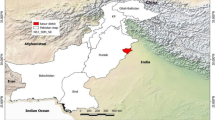Abstract
We surveyed the distribution and status of the long-tailed macaque (Macaca fascicularis umbrosa) in the Nicobar Islands of India. Long-tailed macaques live on 3 islands: Great Nicobar, Little Nicobar and Katchal. There are a total 788 groups. Group size ranged from 25 to 56 individuals with a mean size of 36. Long-tailed macaques are a multimale-multifemale society. Adult males, adult females and immatures constituted 9.7 per cent, 43.2 per cent and 47.1 per cent of the population, respectively. A fairly high ratio of immatures to adult females indicates a healthy population turnover. Vegetation parameters including tree density, canopy cover, canopy height and basal area indicated a still healthful habitats on all the 3 islands. We observed a few threats to the macaques. Measures should be undertaken to ensure survival of the Nicobar subspecies.
Similar content being viewed by others
References
Anonymous. (1972). Wildlife Protection Act 1972, Government of India, New Delhi.
Balakrishnan, N. P. (1989). Andaman Islands—vegetation and floristics. In Saldanha, C. J. (ed.), Andaman, Nicobar and Lakshadweep: An Environmental Impact Assessment, Oxford and IBH Publication, New Delhi, pp. 55-61.
Carew-Reid, J. (1990). Conservation and protected areas in south-pacific islands. The importance of tradition. Environ. Conserv. 17: 29-38
Crocket, C. M., and Wilson, W. L. (1980). The ecological separation of Macaca nemestrina and M. fascicularis in Sumatra. In Lindburg, D. G. (ed.), The Macaques, Van Nostrand Reinhold, New York, pp. 148-181.
Dager, J. C., Mongia, A. D., and Bandopadhay, A. K. (1991). Mangroves of Andaman and Nicobar Islands, Oxford and IBH Publication, New Delhi.
Gibbons, J. D. (1971). Nonparametric Statistical Inference, McGraw Hill, New York.
Kumar, A., Umapathy, G., and Prabhakar, A. (1995). A study on the management and conservation of small mammals in fragmented rain forests in the Western Ghats of south India. Primate Conserv. 16: 53-58.
MacArthur, R. H., and Wilson, E. O. (1967). The Thoery of Island Biogeography, Princeton University Press, Princeton, N.J.
Rodman, P. S. (1991). Structural differentiation of microhabitats of sympatric Macaca fascicularis and M. nemestrina in East Kalimantan, Indonesia. Int. J. Primatol. 12: 357-375
Saldanha, C. J. (ed.), (1989). Andaman, Nicobar and Lakshadweep: An Environmental Impact Assessment, Oxford and IBH Publication, New Delhi
Singh, M. E., Singh, M. R., Kumar, M. A., Kumara, H. N., and D'Souza, L. (1997). Inter and intra-specific associations of non-human primates in Anaimalai Hills, south India. Mammalia 61(1): 17-28.
Singh, M., Singh, M., Kumar, M. A., Kumara, H. N., D'Souza, L., and Sharma, B. A. K. (1998). Behavior of lion-tailed macaque (Macaca silenus) in vulnerable and relatively secure habitats in the rainforests of Western Ghats, India. Tigerpaper 4(XXV): 19-25
Southwick, C. H., and Cadigan, F. C. (1972). Population studies of Malaysian priamates. Primates 13: 1-18.
van Shaik, C. P., van Amerongen, A., and van Noordwijk, M. A. (1996). Riverine refuging by wild Sumatran long-tailed macaques (Macaca fascicularis). In Fa, J. A., and Lindburg, D. G. (Eds.), Evolution and Ecology of Macaque Societies, Cambridge University Press, Cambridge, pp. 160-181.
Tikader, B. K., and Das, A. K. (1982). Glimpses of Animal Life of Andaman and Nicobar Islands, Zoological Survey of India, Calcutta.
Whitmore, T. C. (1986). Tropical Rainforests of the Far East, 2nd edn., ELBS Publication, Great Britain
WRI, (1990). World Resources 1990–1991, Oxford University Press, Oxford.
Author information
Authors and Affiliations
Rights and permissions
About this article
Cite this article
Umapathy, G., Singh, M. & Mohnot, S.M. Status and Distribution of Macaca fascicularis umbrosa in the Nicobar Islands, India. International Journal of Primatology 24, 281–293 (2003). https://doi.org/10.1023/A:1023045132009
Issue Date:
DOI: https://doi.org/10.1023/A:1023045132009




